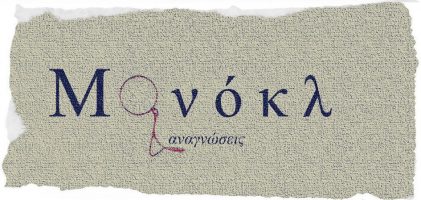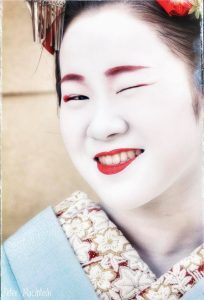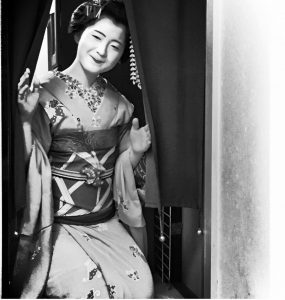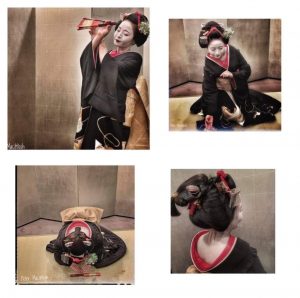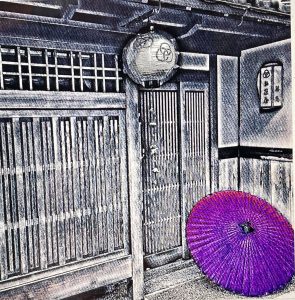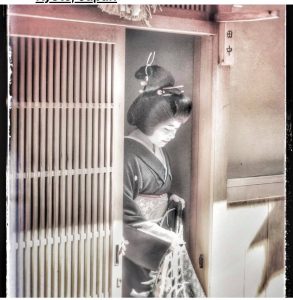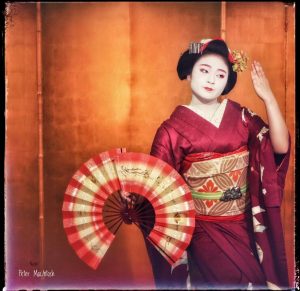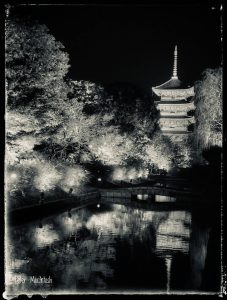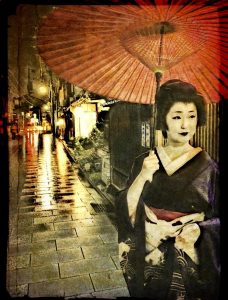Γκέισα:
“Gei” -τέχνη
“Sha” – του ατόμου
Οι εμβληματικές εικόνες των όμορφων γυναικών με τα κιμονό και τα λευκά ζωγραφισμένα τους πρόσωπα, έχουν αντιπροσωπεύσει την Ιαπωνία, από τότε που οι τυπωμένες εικόνες Ukiyo-e έφτασαν στις ξένες ακτές.
Aκολουθώντας αιώνες τώρα τις γυναίκες του Karyukai , ο «Κόσμος λουλουδιών και ιτιών» συνεχίζει να διεισδύει στο μυαλό και τις φαντασίες των δυτικών και των Ιαπωνών.
Γνωστές ως maiko και geiko στο Κιότο, αυτός ο «λαός των τεχνών», δεν είναι απλώς καλλιτέχνιδες αλλά τεχνίτες, που περνούν τις μέρες τους, συντονίζοντας το ρεπερτόριο των τεχνών τους, για να παρουσιάσουν τα βράδια το προϊόν των εργασιών τους. Δημιουργούν και επιμελούνται αξέχαστες εμπειρίες, με τους πιο εκλεπτυσμένους και ευχάριστους τρόπους για το πελατολόγιό τους, που περιλαμβάνει τραγούδι, ποτό, χορό και φυσικά, διασκεδαστική κουβέντα , συνομιλία.
Έχουν την ευκαιρία δώρων χειροποίητων κιμονό και obi αξίας χιλιάδων δολαρίων (εκατομμύρια γιεν), να δειπνήσουν στα καλύτερα εστιατόρια της πόλης και να διασκεδάσουν με διασημότητες από όλο τον κόσμο, δηλαδή μία ευκαιρία σαν τον πρώτο αριθμό του λαχείου, για τις περισσότερες. Ωστόσο, όπως με κάθε επαγγελματία ερμηνευτή, η δόξα δεν έρχεται χωρίς θυσίες. Πρέπει να εγκαταλείψουν τα σπίτια τους στην ηλικία των δεκαπέντε ετών, να μετακινηθούν στην αρχαία πρωτεύουσα , να αρχίσουν να μαθαίνουν να μιλούν σε μια νέα διάλεκτο και να βυθιστούν ολοκληρωτικά στις παραδοσιακές τέχνες, που μέχρι τώρα έχουν δει να παίζονται μόνο στην τηλεόραση ή σε ταινίες. Παρά το όλο μυστήριο και την περιέργεια που δημιουργείται από την κομψή εμφάνισή τους, τον δελεαστικό τους τρόπο, ας μην ξεχνάμε ότι πίσω από τα πορσελάνινα πρόσωπά τους, που μοιάζουν με κούκλες , είναι «πραγματικές γυναίκες» που εργάζονται, αν και ασυνήθιστα.
Peter MacIntosh
Geisha
“Gei”-arts
“Sha”-person of
The iconic images of the kimono-clad beauties and and their painted white faces have represented Japan ever since the Ukiyo-e woodblock prints made their way to foreign shores. For centuries to follow the women of the Karyukai – “Flower and Willow World”- have continued to intrigue the minds and imaginations of westerners and Japanese alike.
Known as maiko and geiko in Kyoto, these “people of the arts”, are not artists per se but artisans who spend their days fine tuning their repertoire of arts in order to present in the evenings, the product of their labors. They create and curate unforgettable experiences in the most refined yet enjoyable ways to their clientele, which includes song, dance drink and of, course, jovial banter/conversation.
The chance to don thousands of dollars (millions of yen) worth of hand-crafted kimono and obi, to dine at the best restaurants in town and to entertain celebrities from all over the world is the draw for most. However, as with any professional performer, the glory doesn’t come without sacrifice. They must leave their homes at age fifteen and move to the ancient capital and begin learning to speak in a new dialect and immediately immersed in traditional arts that until now, they have only seen performed on television or film. Despite all of the mystery and curiosity created by their elegant appearance their demure manner let’s not forget that behind the porcelain, doll-like faces are “real women” doing a job, albeit an unusual one.
κλεισμένη πόρτα
μια ανάμνηση φέρνει
ο μωβ κύκλος της
a closen door
brings back memories
of her round purple
σκύβοντας στο φως
χαμόγελο ντύθηκε
σεμνό στολίδι
bow in the light
she dressed a smile
modest ornament
κόκκινα χείλη,
ποιον Κύκλωπα κρύβετε
στο λευκό κουτί ;
vermilion lips,
which Cyclops are you hiding
in the white box?
χάρτινοι ήλιοι
τον χρόνο ξεδίπλωσαν
σε μια της στροφή
paper suns
unwrapped the time
in her turn
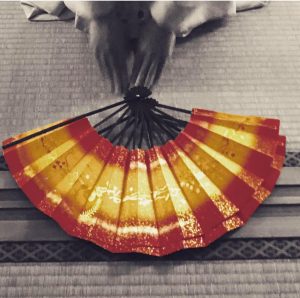
δυο χέρια κρατούν
πολύχρωμη τη ζωή
σε γκρίζο φόντο
two palms are holding
a colourful life
in grey background
μετά το χορό
το λαιμό χαμηλώνει
αύριο πάλι
end of the dance
bowing her neck
please, come again
αντανακλάσεις,
υγρό όνειρο του χθες
νύχτες στο Κιότο
reflections
liquid dream of the past
nights in Kyoto
πλησίασε με
περίπατος στη βροχή
άδεια η πόλη
come closer
walking in the rain
empty city
Peter is a Canadian born mixed-media artist of “the floating world” who came to Kyoto in 1993 and has spent the last three decades, researching, playing, documenting , working and living amongst the geiko/maiko (geisha) in Kyoto’s hanamachi (geisha districts). To see and learn more about his art, research, adventures and even how to experience authentic geisha entertainment, please see his social media showing his unique perspectives and glimpses into this and other fascinating parts of Japanese culture and society.
http://www.petermacintosh.com
https://www.instagram.com/kyotopmac/?hl=en
Maria Papatzelou
 Graduate of the School of Fine Arts of Thessaloniki, a visual artist, scenographer, co-curator of international art projects, radio producer of @ Art in the City, www.entropiaradio.gr and art teacher in Secondary Education. She lives and works in Thessaloniki. She has participated in many group exhibitions, in Greece and abroad (India, London, Kobe , Excellent Prize in International Art Exchange Exhibition Kobe 2017, 2018, 2019 and Kyoto, Japan) and has presented 6 solo exhibitions. She writes Haiku poetry and her first book “Inner Connections of the Liquid Sky” was published in Japan, with translation and comments by Professor Mr. Masashi Nakamura.
Graduate of the School of Fine Arts of Thessaloniki, a visual artist, scenographer, co-curator of international art projects, radio producer of @ Art in the City, www.entropiaradio.gr and art teacher in Secondary Education. She lives and works in Thessaloniki. She has participated in many group exhibitions, in Greece and abroad (India, London, Kobe , Excellent Prize in International Art Exchange Exhibition Kobe 2017, 2018, 2019 and Kyoto, Japan) and has presented 6 solo exhibitions. She writes Haiku poetry and her first book “Inner Connections of the Liquid Sky” was published in Japan, with translation and comments by Professor Mr. Masashi Nakamura.
She is a member of Theater Maiotron since 1994.
